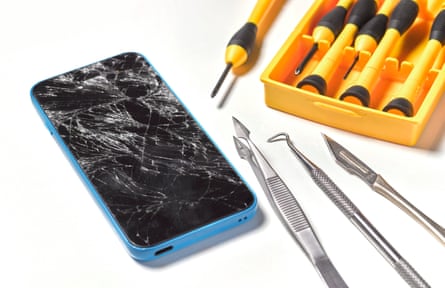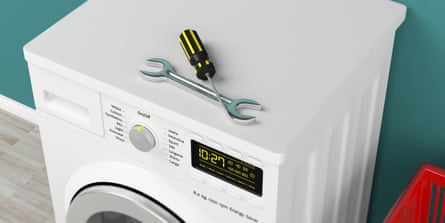My kettle’s broken. It still boils water, but it doesn’t switch off – just boils on, converting the kitchen to a sauna, wastefully, expensively. Put another way, the Polly component still functions well, but Sukey’s lost it. Time to bin it, splash out on a new one. Or maybe not …
Could it be repaired? Could I repair it? “It depends on the kettle and how it was put together,” says Kyle Wiens, a co-founder of iFixit, which publishes free repair guides for consumer electronics and gadgets, as well as selling kits and parts. He’s speaking to me via Skype from San Luis Obispo, California, wearing a T-shirt emblazoned with the slogan “Never take broken for an answer” – and he thinks it sounds as if the switch is the problem.
In Britain a right-to-repair law will come into effect in the summer, meaning manufacturers will be obliged to make parts for products available, to increase the life expectancy of stuff, while also cutting the costs, energy and the need for new materials. “We used not to throw everything away, but now it feels like the default,” says Wiens. “Think about the work and effort that went in, someone put that thing together, then shipped it all around the world to me. When one little thing fails, you have to do all that work over again. It’s very inefficient, and as a result of that, we have secondary effects: environmental destruction from mining and e-waste.”
Before the pandemic did for them, repair cafes were springing up, where you could take stuff along and share expertise. The Restart Project is still running some events online. And look at BBC One’s The Repair Shop, a lovely, if surprising hit. Repair doesn’t just make sense, it’s all the rage.
But what should you attempt to fix yourself, and what’s best left to the experts? And what really does need replacing? Here’s a quick guide.
Easy, go for it
Vacuum cleaner
Often a vacuum cleaner problem will be caused by something like an entangled string, or the belt goes. A belt is simple to swap, says Wiens, “unless you have one of those super-cheap ones that snaps together and then you have to kind of destroy it to get it open. Once in, they’re super easy to work on.” I’m taking Wiens’ “super easy” with a pinch of salt, given that repair is his life; but next time Henry gets sick, he’s going on the operating table.
Power tools
A drill is easy to fix, says Wiens, especially the older ones. If it’s losing power or slowing down, the carbon brushes probably need replacing. “There are these carbon brushes on a spring, there’s usually a flathead screw, and it’s five seconds to swap a brush. It’s a wear part, so it’s designed to be replaced.” Just remember to unplug before going in …
 View image in fullscreenScreen time. Photograph: Peter Dazeley/Getty Images
View image in fullscreenScreen time. Photograph: Peter Dazeley/Getty Images
Mobile phones
We’re just talking about broken screens and replacing batteries here, and how difficult it is depends on the make of phone. Replacing a screen on an iPhone is easier than on a Samsung Galaxy, and actually quite straightforward, says Wiens. There are two screws on the bottom (though you need a special iPhone screwdriver). You open it up, disconnect the cables connecting the screen, put a new screen on. And while the phone’s open, you may as well put a new battery in. “Like the tyres on your car, the battery in your phone wears out after two years, and needs to be replaced,” says Wiens.
Don’t throw it out, but you may need help
Tablets
It’s harder to replace the battery on an iPad than it is on an iPhone because they are glued together. You can get kits with suction cups and gel packs that you put in the microwave to loosen the glue. “You have to work your way round painstakingly with a pick, and it tends to want to glue itself back down when you move on,” says Wiens. “The first time you do this, it’s going to [take] like a couple of hours.”
Laptops
On a Dell or HP laptop, it’s relatively easy to change a battery. Macs and Microsoft Surface laptops are harder. “On the new Macs, it’s challenging because the battery is glued on, so you need a solvent to dissolve the glue so you can get the battery out, to get the new one in.” Hmm, solvent, I’m already out of my depth.
 View image in fullscreenThe door is often the problem on a washing machine. Photograph: Rawf8/Getty Images/iStockphoto
View image in fullscreenThe door is often the problem on a washing machine. Photograph: Rawf8/Getty Images/iStockphoto
Washing machine
All washing machines have doors, and often the problem is with the switch or lock on the door. That’s what went wrong with Wiens’, it wouldn’t drain. “I just bypassed the switch and it drained,” he says, so he got a new switch. Again, bypassing switches sounds a bit like bypass surgery – I don’t think I’m qualified, I’m calling someone for help. Waving not drowning, though, and certainly not throwing.
Don’t bother trying
Old TVs
The old-fashioned cathode ray tube sets are best left alone, says Wiens – because of the vacuum, they’re likely to implode. If it’s a new TV, though, get involved! If it doesn’t turn on, it may be the power board, which generally fails before everything else. Easily replaced.
Microwaves
The switches or the LEDs on the front are quite straightforward, says Wiens. Once you start getting into the magnetron, which produces the microwave energy, then it starts to get a little tricky. “Generally we say to stay away from microwaves, unless you know what you’re doing.”


